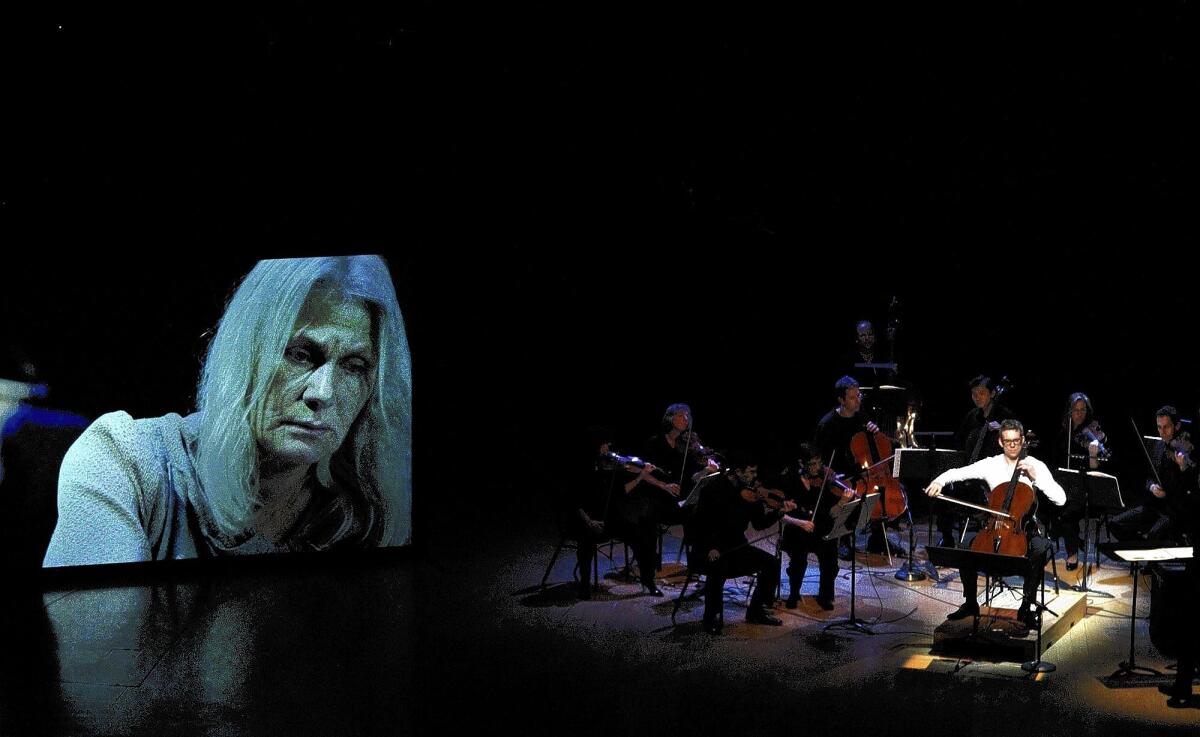Review: Green Umbrella swings with Michel van der Aa’s ‘Up-close’

- Share via
A screen for film or video projection has become a common occurrence at concerts, multimedia being a way of 21st century musical life. A floor lamp on the stage of Walt Disney Concert Hall on Tuesday night was, maybe, a curious homey touch, but hardly eccentric when a green umbrella is the trademark of the Los Angeles Philharmonic New Music Group. The lamp could even have been something stagehands forgot to throw away after the orchestra’s last Green Umbrella extravaganza in November, a messily prop-crazed production of Frank Zappa’s “200 Motels.”
The lamp here, though, served as a symbol of the uncanny in the West Coast premiere of Michel van der Aa’s “Up-close.” This half-hour concerto for cello, chamber string orchestra, electronics and film, all by the 43-year-old Dutch composer, is a trek out of the chamber and into a new corner of virtual reality.
The cello soloist is haunted by a film, in which a woman played by Dutch actress Vakil Eelman is on a stage just like the one the live musicians are on. In the film, there is a lamp just like the one at Disney. The woman is first seen writing some kind of code. Later, she runs frightened in a forest, gathers bits of foil, obsessively puts them in jars in her house and then proceeds to make a kind of cyberpunk music box using old tube equipment. She looks ever on the verge of a scream.
CRITICS’ PICKS: What to watch, where to go, what to eat
Van der Aa wrote “Up-close” for cellist Sol Gabetta and first staged it in Stockholm two years ago. Eelman was meant as the cellist’s alter ego, and the soloist, at times, interacted with the film. She, for instance, got up and grabbed the lamp, just as Eelman did. Eelman’s expressions of angst also transferred to the cellist.
“Up-close” has caught on — it won last year’s coveted $100,000 Grawemeyer Award — and other cellists are taking it on. Tuesday night, Johannes Moser became the work’s first male soloist. He was a surprising choice also because his style of playing is one of understated eloquence.
The change of sex mattered. No longer alter ego, the woman in the film became more like a poignant maternal memory, and that proved a highly effective new touch.
But “Up-close” still remains primarily a concerto. The piece wouldn’t mean a thing if it didn’t swing. It does. Evocative as all the theatrical business is, the choreography and film are embellishments. The concerto itself, which is in three movements, conveys essential musical drama through the ferocious, thick chords Moser played at the beginning, the eerie quiet of slow trills and held tones in the middle movement and the feverish, folkish Finale.
PHOTOS: Best classical concerts of 2013 | Mark Swed
The orchestral strings are more background than foreground, with the electronic music and film sound effects sounding effortlessly mixed in. Most important, the film is used selectively and cautiously, never allowed to step on the toes of the score.
Whether up close next to the screen or in his soloist chair, Moser was gripping as an actor, more gripping with the cello and bow in his hands. Brad Lubman conducted with the kind of active involvement that made it seem as though he might have liked to be part of the action as well.
He was part of the theatrical action in the concert’s first half. The program began with Pierre Boulez’s “Éclat,” a 14-minute piece for 14 players, in which bright percussive instruments (such as harp, celesta, mandolin, cimbalom and percussion) are contrasted with sustaining ones (strings, brass and winds).
PHOTOS: Arts and culture in pictures by The Times
Though not acknowledged in the program, “Éclat” has a place in Los Angeles history. It was commissioned by the Monday Evening Concerts for the public opening of the Los Angeles County Museum of Art in 1965. Boulez conducted, cuing players (the score is modular and entrances are improvised by the conducted on the spot) with the smooth elegance of a French gendarme directing traffic.
Lubman’s gestures were closer to karate. He is, in many ways, the electric Georg Solti of new music. The performance sizzled.
Elliott Carter’s Triple Duo, from 1982, provided yet another sort of musical drama. The duos are flute-clarinet, piano-percussion and violin-cello, and they were inspired by Indian vocalists the Dagar Brothers. The music is dense, complex and switching perspective.
The duos could be likened to couples walking down the street. Each of the six people has a recognizable personality and each couple its own dynamics. The audience’s perspective is watching them while sitting in an outdoor café.
Lubman conducted with insistent gusto and an impressive rhythmic dexterity. This is unforgiving music, and the performance began nervously. But once the L.A. Phil players settled down, the three duos became sonically as vivid as if these were characters observed up close on screen.
More to Read
The biggest entertainment stories
Get our big stories about Hollywood, film, television, music, arts, culture and more right in your inbox as soon as they publish.
You may occasionally receive promotional content from the Los Angeles Times.











